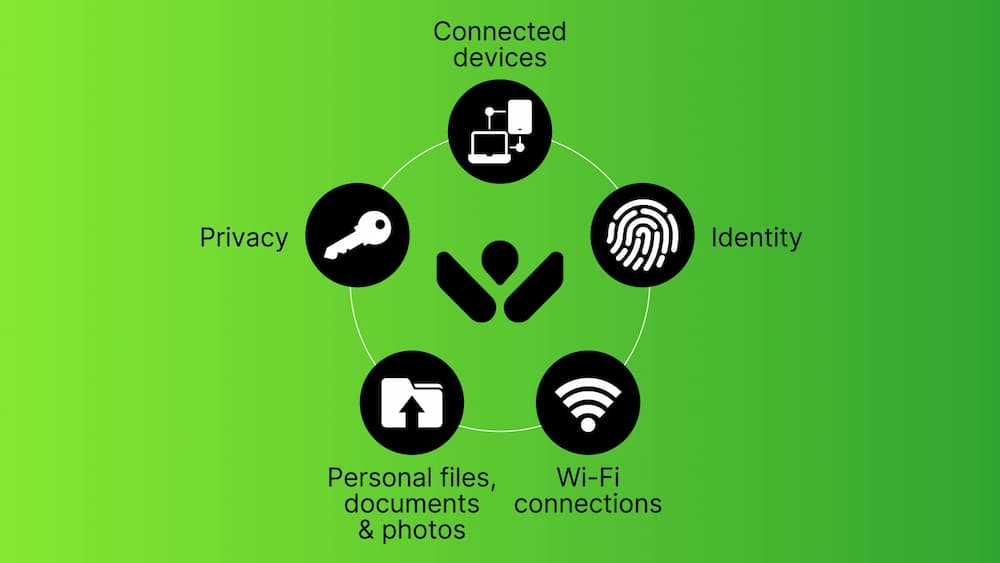World Backup Day: Pledge to protect your digital life
Our digital lives are filled with essential personal information, and it’s easy to forget how vulnerable all that data can be. But if your hard drive crashes, your laptop gets stolen, or you fall victim to cybercrime, the loss can be devastating. Your financial records, your work files, and even years of family photos can disappear in and instance. It’s a nightmare scenario that happens more often than you think. That’s why March 31st is World Backup Day, serving as a reminder that the right backup strategy can save you the frustration, cost, and the heartache of losing information that’s dear to you.
Backing up your data simply means creating copies of your important files and storing them in secure, encrypted locations. This ensures that even if something goes wrong and your data disappears, you’ll be able to recover it. Yet, many people don’t take these important steps to protect their digital lives. Despite all the risks, 20% of people rarely or never back up their data, leaving them vulnerable to irreversible loss.
Common causes of data loss
- Human error: This is the number one cause of data loss, according to a report highlighted in PC World. Nobody’s perfect, and we all run the risk of accidents, from deleting files to spilling coffee on a laptop.
- Hard drive failure: It happens! Hard drives are a great way to backup, but these devices can and do suffer data loss. Many hard drives fail in less than three years, and it’s been found that the newer drives have shorter lifespans than those manufactured before 2015.
- Software corruption: When software or data is damaged, it can become unusable or unreadable. This can be caused by software bugs, hardware failures, viruses and malware, resulting in system crashes or data corruption.
- Malware and ransomware attacks: Cybercriminals also deploy malware to lock, steal, or destroy your files. Ransomware is a type of malware that prevents you from accessing your files and demands a ransom for their return.
- Natural disasters and theft: Threats like fires and floods, as well as burglaries and robberies, can lead to crippling data loss if all your information is stored in just one vulnerable place.
The 3-2-1 backup strategy
Avoiding common threats can be as easy as 1-2-3, or should we say 3-2-1? By using the 3-2-1 backup rule, you’ll give yourself comprehensive protection against the many forms of potential data loss.
- 3 Copies: always keep three copies of your data- your original plus two backups.
- 2 Different Media Types: Store your backups on two different types of media – for example, use an external hard drive and a cloud storage service, like Carbonite. Using encryption is also crucial for protecting against data loss because it transforms sensitive information into an unreadable format.
- 1 Offsite Backup: Keep at least one backup in a different physical location, like a separate worksite or a safety deposit box.
Backup options to consider
- External hard drives
These are great for local backups, but can be vulnerable to theft, damage, and hardware failure. - Cloud backup services
Look for cloud-based solutions that offer encrypted, automatic, and unlimited backup to ensure files are always protected. Carbonite makes it easy to continuously and securely backup all your data with 128-byte protection. And because all backups are stored offsite, in the cloud, you can easily access them anytime, anyplace, and restore them with just a click. - Network-attached storage
A network attached storage (NAS) device is a dedicated file storage system connected to a network, which enables data sharing across various devices.
Why backing up is essential
- Protects your important data from hardware failure, cyber-attacks, and accidental deletion.
- Ensures that your valuable data is encrypted, secure, and accessible when you need it.
- Saves you the time, money and stress associated with attempting to recover lost data.
- Preserves your cherished personal memories, like photos and videos, from being lost forever.
- Helps maintain business continuity by offering a quick recovery from data loss.
- Offers businesses resiliency and compliance across their organization.
Backup action plan
✅ Test your backups regularly: Check that your files are retrievable on a regular basis.
✅ Set a backup schedule: Automate the frequency of your backups according to your needs.
✅ Create a backup strategy: Prioritize which documents, photos, and databases need protection first.
✅ Create a disaster recovery plan: Outline steps for restoring data in case of an emergency.
✅ Use antivirus protection: Secure your system with antivirus protection to prevent malware and ransomware attacks.
✅ Use an offsite, secure, and unlimited solution like Carbonite for cloud backup:
- Offers options for individuals and businesses
- Automatic and continuous backup: No need to manually backup files
- End-to-end encryption: Keeps your data private and protected
- Easy file recovery: Restores lost or deleted files with just a few clicks
- Multiple device support: Protects desktops, laptops, and external drives
Take the World Backup Day pledge
There’s never been a better time to make backing up your data part of your routine. Make a promise to protect yourself today by taking this official pledge. “I solemnly swear to backup my important documents and precious memories on March 31st.” Then take a few simple steps to get started.
- Create your first backup
- Try the 3-2-1 backup strategy
- Secure your digital life with Carbonite
Backing up your files isn’t just about security, it’s about peace of mind. This World Backup Day, start building your own good backup habits. Protect your files and photos and finances now, because if disaster strikes you may never see them again. Consider this your wakeup call to make data protection a priority. Your future self will surely thank you!
Looking for more information and solutions?
National Consumer Protection Week: Keeping your personal data safe in a digitally connected world
March is a time for leprechauns and four-leaf clovers, and as luck would have it, it’s also a time to learn how to protect your private data from cybercrime. Each year, the first week of March (March 2-8) is recognized as National Consumer Protection Week (NCPW). During this time, many government agencies and consumer protection organizations come together to help educate consumers on how to keep their personal and financial information secure.
The event is sponsored by the Federal Trade Commission (FTC), and other participating agencies include the Federal Deposit Insurance Corporation (FDIC), AARP, and the Better Business Bureau (BBB). This month, take advantage of all that NCPW offers, including access to free tools and information that can help you identify and prevent online scams, fraud, and identity theft.
The growing risks to your data
- During the third quarter of 2024, data breaches exposed more than 422 million records worldwide. Millions of customers were put at risk when their social security numbers, phone numbers, and other sensitive personal information were leaked.
- As of 2024, the average cost of a data breach in the United States amounted to $9.36 million. In comparison, the global average cost per data breach was $4.88 million.
- The most common causes of leaks were operating system (OS) flaws and weaknesses on devices like computers and phones. For example, when a user forgets to log out before they leave their computer, it can open the door for cybercriminals to steal information. In fact, it’s estimated that careless users are responsible for about 70% of sensitive data loss.
Common attacks to consumer protection
- Identity theft and fraud
Some common types of identity theft and fraud include account takeover fraud, when criminals use stolen personal information such as account numbers, usernames, or passwords to hijack bank accounts, credit cards, and even email and social media accounts. - Online shopping scams
An online shopping scam usually involves a fake online store or app, which appears legitimate and is promoted on social media or other authentic websites. - Financial fraud
With the advent of artificial intelligence (AI), financial fraud tactics are growing more sophisticated, and sadly, they often target older people. For example, grandparent scams happen when someone who sounds like a grandchild or other relative contacts an older person and asks them to send money via wire transfer to help get them out of trouble. Scammers use AI to clone voices, which helps them convince you that you’re sending money to a family member who desperately needs your help. - Medical identity theft
Medical identity theft happens when someone steals or uses your personal information like your name, Social Security number, or Medicare details, to get healthcare in your name. This kind of fraud can disrupt your medical care and cost a lot of money to resolve. - Social engineering attacks
Social engineering attacks occur when someone uses a fake persona to gain your trust. They deceive you into divulging confidential information so they can steal your money. Contact is usually made through social media, by phone or in person.
How to protect yourself and your data
- Smart ways to secure your devices
- Strong passwords – Make them long, random, and unique.
- Password managers – Automatically generate and store strong passwords.
- Antivirus protection – Software that protects against viruses and malware.
- Solutions – Webroot Premium and Webroot Essentials offer ultimate protection and include password managers.
- Best practices for financial diligence
- Credit monitoring services – Keep an eye on your credit for you.
- Fraud alerts and credit freezes – Protect you from identity theft.
- Secure payment methods – Ensure safe processing of financial transactions.
- Protect your identity – Webroot Premium provides identity protection for up to 10 identities, including financial account and credit monitoring, and dark web monitoring.
- Beware before you share
- Phishing scams – Avoid clicking on malicious links in emails and social media.
- Unsolicited calls or emails – Be wary about sharing personal details with people you do not know.
- Make sure businesses and organizations are legitimate – Confirm you’re dealing with a trusted source.
- Webroot Essentials and Webroot Premium – Offer peace of mind with device, identity, and privacy protection.
- Practice personal Information management
- Data minimization strategies – Provide the least number of private details necessary when filling out forms or answering questionnaires .
- Social media privacy – Avoid sharing personal information on social media.
- Document disposal – Shred sensitive documents.
- Backup solutions – Carbonite automatically backs up and protects your data.
It takes more than good luck to protect your private data and finances from cybercriminals, so be sure to grab this opportunity to learn more about staying safe from online fraud.
Looking for more information and solutions:
Digital life protection: How Webroot keeps you safe in a constantly changing world
Nearly every aspect of life is connected to the internet, so protecting your devices, identity, and privacy has never been more critical. Cyber threats are no longer just the occasional virus or suspicious email. Phishing scams, ransomware attacks, data breaches, and identity theft are part of a growing list of online dangers that are a daily reality.
For over 25 years, Webroot has been on the front lines of cybersecurity, protecting millions of people and businesses from evolving threats. What began as antivirus product has expanded into a comprehensive portfolio to secure your entire digital life. With our all-in-one solutions, we’ve created a new standard for digital security—because safeguarding your devices, data, and identity in an increasingly interconnected world is not optional, it’s essential.
Let’s explore how Webroot has evolved to become your one-stop shop for all things cybersecurity.
Introducing Webroot Total Protection: Comprehensive security for the modern world
When you think about cybersecurity, you probably think of antivirus protection—and rightly so. But as technology advances, so do the threats. Today, your personal information, online activities, financial data, and even your family’s privacy are targets for attack.
That’s why Webroot has gone beyond traditional antivirus solutions to create Webroot Total Protection, a powerful all-in-one security suite that provides everything you need to stay safe online.
What is Total Protection?
Total Protection is a robust, comprehensive solution that safeguards not just your devices but also your online identity, files, and privacy. It combines multiple security capabilities into one easy-to-use package that includes:
- Antivirus protection
Detects and neutralizes viruses, malware, spyware, and ransomware. - Password Manager
Ensures your passwords are strong and secure, while also making them easy to access and manage. - Identity protection
Guards against identity theft by monitoring your personal information and alerting you to potential breaches. - VPN (Virtual Private Network)
Protects your privacy while browsing online, ensuring your data isn’t intercepted or tracked. - Secure backup
Keeps your critical files safe from data loss or ransomware attacks. - Parental controls
Helps you protect your family by limiting access to inappropriate or harmful content online.
With Total Protection, you can confidently navigate the digital world, knowing your devices, identity, family, and personal data are secure every step of the way.
What does Webroot Essentials include?
Webroot Essentials provides foundational protection against today’s most common cyber threats, including:
- Antivirus and anti-malware
Detects and neutralizes viruses, malware, spyware, and ransomware. - Browser protection
Keeps you safe while you browse and shop online, surf the web, and connect on social media. - Anti-phishing protection
Shields you from phishing attempts. - Password Manager
Helps you securely store and manage your login credentials.
With Webroot Essentials, you get exactly what you need to protect yourself, your devices, and your personal information—all in a package that’s simple to use and designed for everyday security.
The benefits of Webroot Total Protection and Essentials
The internet has become an integral part of everyday life. From online shopping and banking to remote work and social media, most of us spend a significant portion of our lives connected. While this connectivity brings convenience, it also comes with risks. Cybercrime is increasing at an alarming rate, targeting individuals and families just as often as businesses. Some of the most common threats include:
- Phishing involves fraudulent emails or websites designed to trick you into revealing sensitive information.
- Identity theft happens when criminals steal your personal information to commit fraud or theft.
- Ransomware encrypts your files and demands payment to release them.
- Data breaches occur when hackers gain unauthorized access to and steal sensitive files and information.
- Viruses and malware programs harm your devices or steal your data.
As these threats become more sophisticated, having robust, multi-layered protection is essential. That’s why Webroot is dedicated to constant innovation, delivering advanced solutions that stay ahead of cybercriminals and adapt to the ever-changing digital landscape to keep you safe.
- Protection for your growing number of devices
With the growing number of devices in every household—laptops, smartphones, tablets, and more—it’s crucial to have security that can keep up. Webroot offers packages designed to cover multiple devices, so you can keep your entire household protected. - Dedicated to innovation
New threats emerge daily. Backed by a dedication to constant innovation, Webroot’s solutions leverage advanced technology to detect and neutralize threats in real time, ensuring you stay protected from cyber-attacks before they can do harm. - Peace of mind for families
Features like parental controls and identity protection give families an added layer of security, so parents can rest easy knowing their children are safe online. - Powerful data protection
With secure backup included in Total Protection, you don’t have to worry about losing important files to ransomware, malware, or accidental deletion. - Effective antivirus protection
In an era where cyber threats are constantly evolving, some people might wonder: Is antivirus protection still necessary? The answer is a resounding yes. Viruses and malware are still very real dangers, and strong protection remains the cornerstone of any good cybersecurity strategy. Webroot’s antivirus technology is constantly updated to protect against the latest threats, and it works seamlessly with our other security tools to provide comprehensive protection. - A trusted name in cybersecurity
Webroot has spent over two decades perfecting our products, earning the trust of millions of users around the world. Whether you’re a tech-savvy professional or a casual user, we’re here to make security simple and effective.
Protect Your digital life with Webroot
Webroot has spent 25 years adapting to the ever-changing cybersecurity needs, and we’re not stopping anytime soon. With our all-in-one solutions like Webroot Total Protection and Webroot Essentials, we’re proud to offer powerful, easy-to-use tools that meet the demands of your modern digital life.
Whether you’re looking to safeguard your devices, protect your family, or secure your online identity, Webroot has you covered. Because in a world where cyber threats never rest, neither do we.
Is your whole digital life protected? 4 ways to address common vulnerabilities
Cyber threats. Identity theft. Online profiling. Financial fraud. Social media misuse. The list just gets longer. As more aspects of our lives move online and digital devices proliferate, staying safe from threats has become more important than ever.
Consider all the connected devices you use for daily tasks—browsing, shopping, banking, gaming, and more. Then think about all the content that you share on these devices every day; much of it likely contains sensitive or critical information that, in the wrong hands, could lead to serious damage with long-lasting impact.
The solution? Comprehensive digital protection. Webroot Total Protection is the latest release in our Customer Digital Life Protection strategy that checks all the boxes. It’s a top-end, true all-in-one offering based on a new platform that combines antivirus, password manager, identity protection, VPN, backup, and parental controls.
1. Protect your devices from viruses
How confident are you that your digital music, photos, and important documents—as well as email and applications—are safe? Cybercriminals are constantly developing new malware, ransomware, and phishing attacks that can steal identities, encrypt memorable family photos and documents for ransom, and turn home computers into devices that criminals take over to send spam or steal data.
Effective security software shields you from worms, trojans, adware, and more. And it protects not just your PC and laptop, but also your tablets, smartphones, and other digital devices.
Comprehensive antivirus software is most effective when used in conjunction with security best practices. Here are a few:
- Make sure your antivirus software performs scans regularly
- Install the latest security patches for your operating systems
- Keep your antivirus software up to date
- Be careful when downloading new apps onto devices; only download from app stores you trust
- Regularly backup important data

2. Protect your privacy in your online activities
Sharing information has become commonplace in our digital lives. From purchasing a plane ticket to opening a bank account and registering to vote, or simply doing your grocery shopping online, getting through the day without sharing at least some personal information online seems nearly impossible.
The flip side to this convenience, however, is that we risk losing control over who can access our personal information. Malicious actors are constantly seeking to collect personal data to commit fraud, steal identities, harass and threaten individuals, and more.
Protecting privacy is a top priority for families facing growing threats. Password managers generate strong, unique passwords and simplify their use, protecting you and saving time by automatically filling in credentials for website and app logins. Besides, using a VPN (Virtual Private Network) that establishes secure connections to public Wi-Fi hotspots by encrypting data transmission will keep you safe and anonymous when you’re away from home.
By paying attention to your device settings you can take steps to protect your privacy across your digital life:
- Social media: Choose who can see your posts, photos, and personal information and review these settings regularly. Set your default sharing settings to “friends” or a more restricted group rather than “public.” Check which third-party apps have access to your account and remove those you no longer use.
- Mobile devices: Disable location, camera, microphone, and contact list access for apps that don’t truly need them. Consider turning off location services when not needed and review which apps track your location in the background.
- Web browsers: Clear your browsing history and cookies regularly, block third-party cookies, and enable “do not track” features. Review and manage which sites can send you notifications, access your location, or use your camera/microphone.
- Smart home devices: Review privacy settings for voice assistants like Alexa or Google Home regularly. Check what data these devices collect and adjust accordingly.
- Email services: Keep tabs on apps and services that have access to your email account. Adjust spam filter settings to your preferences.
- Operating systems: Check your privacy settings to control app permissions, data access, and tracking features.
3. Safeguard your identity and private information
Once only seen in spy movies, identity theft today is very real, and poses serious financial, legal, and personal consequences. Bad actors can drain your bank accounts, open fraudulent credit cards, take out loans, file false tax returns, obtain medical services in your name, and more. The results range from damaged credit and mounting debt to inaccurate medical records and reputation damage.
Some steps you can take to protect your identity include:
- Monitoring financial activity: Check bank and credit card statements each month for unauthorized charges. Set up alerts for unusual transactions and review your credit reports.
- Securing personal information: Only share Social Security numbers, birth dates, or account numbers when absolutely necessary. Shred or securely dispose of documents containing sensitive information and keep important documents in a secure location.
- Be wary of scams: You shouldn’t respond to unsolicited phone calls, emails, or texts requesting personal information—legitimate organizations typically won’t ask for sensitive details through these channels.
- Consider additional protection: Identity theft protection services monitor your credit and personal information for suspicious activity and alert you to anomalies. Many will also reimburse up to $1 million for fraud expenses, stolen funds, and related costs such as lawyer and expert fees, lost wages, private investigator charges, and additional childcare or eldercare. They can also help you re-establish your identity—on average it takes 200 hours to restore an identity after fraud.
How does an identity protection plan work?
Usually such services include a secure online portal where you can register your personal data, like date of birth, driver’s license, SSN, account numbers, and more. Once you subscribe, make sure to take the time to create your profile and that of your family members, so you can start getting identity health reports and rapid alerts right away in case anything fraudulent is detected!
If identity theft does happen, freeze any accounts with fraudulent charges and establish a fraud alert with credit bureaus. You can file an official identity theft report with the Federal Trade Commission at IdentityTheft.gov. Contact relevant organizations, such as the Social Security Administration if your SSN was stolen. Close compromised accounts and open new ones with different account numbers, and new passwords and PINs.
If you think the process of restoring your identity after theft is daunting, rest assure that cybersecurity or insurance companies offer identity protection plans that include the help of a remediation expert, who can guide you through the process. These professionals have in-depth knowledge of identity theft laws, credit reporting procedures, fraud resolution practices, and how to interact with various institutions to resolve issues effectively.
Protect the data, document and precious memories stored on your devices
Theft isn’t the only threat to data – consider the impact that hardware failures, coffee spills, and accidental deletions can have on favorite photos, digital memories, and other unreplaceable items. This is where data encryption and automated backups come in.
Data encryption protects data by translating it into a different, unreadable form using an encryption key. When it’s in that encrypted form, only someone with the unique decryption key or password can translate the data back into its readable state. Encryption is one of the most effective and widely used forms of data security available.
With automated backup you can create a backup schedule that you can set and forget. Back-up files are typically uploaded to the cloud so they are accessible from anywhere. Changes that you make on your files are reflected in the backup ones.
Data protection best practices include:
- Follow the 3-2-1 backup rule: three copies of data, on two different types of media, with one copy off-site
- Test restore procedures regularly
- Keep encryption keys and passwords secure but accessible
- Monitor backup logs and storage capacity
- Regularly update backup software for security patches
You may already be protected in one or several of these areas,
but how could you make sure you truly have comprehensive protection?
Introducing Webroot Total Protection
With the mounting threats out there, it’s time to consider comprehensive digital protection so you can rest easy that your devices are safe and your content, identity, and privacy are protected. Webroot Total Protection empowers families to enjoy their digital life to the fullest by protecting connected devices, documents, best memories, online transactions, and identities in a way that’s flexible and affordable.
Learn more about what Webroot Total Protection can do for your digital life.
MSPs weigh in: Key SOAR benefits driving MDR success
OpenText recently surveyed 255 MSPs to uncover key trends shaping the future of Managed Detection and Response (MDR). One technology area it explored was security orchestration, automation, and response (SOAR)—the workhorse behind automating security workflows. The survey revealed several key benefits of SOAR in MDR, highlighting how it can help MSPs and SMBs improve incident response, reduce alert fatigue, and deliver round-the-clock security.
SOAR is a technology that enables security teams to automate and streamline their workflows—from threat detection to response. It integrates and coordinates security tools and processes, helping analysts handle and respond to incidents. By automating repetitive tasks, such as triaging alerts and executing response actions, SOAR reduces manual effort and speeds up incident resolution. This improves the overall effectiveness of security operations, making it a critical component of modern MDR solutions.
Real-world benefits of SOAR for MDR solutions
Automation of common tasks
In the survey, 30% of MSPs pointed to automation of common tasks as the most valuable benefit of SOAR within an MDR service—and it’s easy to see why. Automation allows MSPs to streamline repetitive tasks like alert triage and standard response workflows. By speeding up incident resolution and ensuring consistent, accurate responses, SOAR helps MSPs address threats swiftly and effectively. This not only reduces the burden on security teams but also enables them to outpace adversaries and deliver stronger protection for their customers.
Improved 24/7/365 protection and after-hours response
Cybercriminals know that timing is everything. They often strike outside of business hours—late at night, on weekends, or during holidays—because they count on reduced staffing and slower response times to give them the upper hand. However, with MDR services leveraging SOAR, cybercriminals lose their “after hours advantage.”
According to the survey, 27% of MSPs identified improved 24/7/365 protection and after-hours response as a top SOAR benefit as part of an MDR solution. By automating detection and response using customizable workflows, SOAR ensures security measures are always on, regardless of the time or day.
Reduced alert fatigue
Alert fatigue is one of the most pressing challenges for security teams today. When bombarded with an overwhelming number of alerts, it’s easy for critical threats to get lost in the noise. SOAR directly tackles this issue, helping MSPs streamline their processes and focus on what really matters. In fact, 24% of MSPs in the survey noted that SOAR’s ability to reduce alert fatigue thereby improving accuracy and confidence was a key benefit for an MDR solution.
SOAR works by automatically analyzing security alerts against predefined rules and context, escalating the most critical threats to the surface. This not only sharpens the accuracy of responses but also enables security teams to act quickly and decisively. Security teams can use SOAR to create workflows to remediate the high-priority incidents that truly need attention, ensuring that any financial and reputational damage is minimized
Centralized incident management with enriched alerts
When it comes to incident management, having a disjointed view can slow down response times and make it harder to pinpoint the right course of action. That’s why 19% of MSPs in the survey highlighted centralized incident management and enriched alerts as one of the top benefits of SOAR for an MDR solution.
Alerts are enriched with the latest threat intelligence, which provides security teams with vital context. This deeper layer of information helps analysts understand the full scope and severity of an alert, allowing them to make quicker, more informed decisions. With SOAR, all relevant data is centralized in one platform, giving security teams a unified view that enhances their ability to respond effectively and prioritize the most critical threats without missing crucial details.
MDR with SOAR helps MSPs differentiate their offering
For MSPs, leveraging SOAR capabilities in their MDR offerings is a strategic move that can significantly enhance their service delivery. By focusing on the key benefits of automation using workflows, 24/7 protection, reduced alert fatigue, and centralized incident management, MSPs can provide a superior level of security that meets the evolving needs of their SMB clients. This differentiation not only improves client outcomes but also positions MSPs as leaders in the competitive security services market.
Incorporating SOAR into MDR services enables MSPs to offer a more efficient, reliable, and comprehensive security solution. With SOAR automating routine tasks, improving after-hours response, reducing alert fatigue, and centralizing incident management, MSPs can ensure that their clients receive the best possible defense against cyber threats. This approach not only enhances the overall security posture of SMBs but also builds trust and confidence in the MSPs’ ability to safeguard their clients’ digital assets.
Final thoughts
When MSPs choose to partner with a vendor for MDR, it’s important to select one that integrates SOAR into their offering. By doing so, MSPs can deliver a modern, proactive MDR service that improves security posture and provides the best experience for their SMB customers. SOAR accelerates response actions to stop adversaries in their tracks at every turn, ensuring that MSPs can swiftly detect and respond to threats before they inflict damage. With SOAR at the core, MSPs can offer a superior MDR service that adapts to the rapidly changing threat landscape, keeping their customers secure, happy, and confident.
The rising role of cloud-based SIEM in MDR: What MSPs need to know
OpenText recently surveyed 255 MSPs to uncover key trends shaping the future of Managed Detection and Response (MDR). The findings reveal not only what cybersecurity professionals are prioritizing but also how MSPs can better meet the evolving demands of their small and midsize business (SMB) customers.
One key takeaway from the survey: 81% of respondents rated cloud-based SIEM (security information and event management) as important to include in their MDR solution.
Why is cloud-based SIEM such a big deal for an MDR? Because for MSPs delivering MDR services, it’s the backbone that makes scalability, visibility, central and efficient threat management possible.
Cloud-based SIEM is an essential MDR backbone
The modern attack surface is vast. Business customers are spread across hybrid infrastructures with data flowing through endpoints, networks, applications, and the cloud. Cloud-based SIEM-powered MDR services help MSPs stay on top of this complexity by serving as the single source of truth for detecting and responding to threats.
Here’s why it matters:
- Seamless data ingestion
Cloud-based SIEMs ingest security telemetry from diverse sources—EDR solutions, applications, cloud infrastructure, network packet data, and more—to deliver a holistic view of a customer’s environment. - In-depth correlation and analysis
By correlating data across borderless infrastructures, SIEM provides security analysts with the context they need to identify, prioritize, and address the most impactful threats. - Scalability and accessibility
As businesses grow, so do their security needs. Cloud-based SIEM scales effortlessly, ensuring an MSP’s MDR services can handle large data volumes without compromising performance. Plus, analysts can access SIEM insights anywhere, anytime.
In short, a cloud-based SIEM ensures that no corner of the customer’s attack surface is left unseen—from endpoint to cloud. It provides comprehensive visibility, continuously collecting, correlating and analyzing data from every layer of the IT environment. This means the MDR service can detect threats wherever they may arise, whether on-premises, in the cloud, or across hybrid infrastructures, giving MSPs the ability to respond quickly and effectively to any potential risk.
How SIEM drives faster MDR outcomes
Cyberattacks move fast. MSPs delivering MDR services need tools and processes that can keep pace with today’s threats. A cloud-based SIEM is the essential technology that enables the MDR service to deliver rapid detection, triage and investigation. Here’s how SIEM supports faster outcomes across every stage:
- Rapid detection: A cloud-based SIEM continuously ingests and correlates syslog data from all sources, reducing the time it takes to identify a threat after it emerges.
- Time to triage: By consolidating telemetry into a centralized platform, SIEM enables security analysts to quickly assess and prioritize incidents—cutting through the noise to focus on the most critical threats.
- Accelerated investigation: SIEM by leveraging threat intel provides the context analysts need to understand a threat, pinpoint its origin, and determine its potential impact—all without needing to manually stitch together insights.
Expert-led, SIEM-enabled
When MSPs choose an MDR partner solution with a cloud-based SIEM at its core, they unlock more than just a sophisticated tool. They gain the advantage of expert-led security teams that can leverage the full potential of the SIEM platform to deliver rapid, precise, and continuous threat detection.
The survey results highlight that MSPs see the distinct advantage of running an MDR service with a cloud-based SIEM, which enhances their ability to run a 24/7/365 security operations center (SOC). With SIEM as the central hub, security experts can quickly surface suspicious activity, centrally manage investigations and take swift action.
The value of expert-led, SIEM-enabled MDR becomes even clearer when you consider the following benefits:
- Round-the-clock SOC with seamless investigations
The ability to monitor and respond to threats 24/7X365 is critical for an MDR service. By consolidating threat data into a centralized cloud SIEM, experts can detect malicious activity at any time of day or night. This continuous monitoring reduces the risk of attackers moving undetected, ensuring that threats are neutralized before they can cause harm. - Single, integrated tool for investigation
The MDR survey results highlight the value MSPs place on having a unified toolset for threat detection and investigation. A cloud-based SIEM with threat intel provides this central hub, enabling security teams to efficiently assess the scope of incidents, prioritize based on severity, and track the attack’s progress in real-time. The SIEM can correlate data across multiple environments—whether it’s endpoint data, network logs, or cloud infrastructure—ensuring nothing slips through the cracks. - Expert insight into threat context
The SIEM doesn’t just provide raw data; it enriches that data with valuable context from threat intel , helping the MDR security experts to identify the root cause of a threat, its potential impact, and the fastest path to resolution.
As cyber threats become more relentless and attack surfaces continue to expand, MSPs are in a unique position to help SMBs stay secure. OpenText’s MDR survey results highlight what’s clear: a cloud-based SIEM as part of an MSP’s MDR solution is a priority set up. It allows MSPs to deliver consistent, effective threat detection and response.
By combining the right technology with the right expertise, MSPs can navigate the complexity of today’s cybersecurity landscape and give their customers the confidence to focus on what matters most: growing their business.
Protect those you love from internet scams this Valentine’s Day
February is a great month to refresh your cyber awareness skills. February 11 marks Safer Internet Day, encouraging us to work together to make the internet a safer and better place. It’s the perfect time to learn more about cybersecurity risks and best practices for protecting yourself and your loved ones online.
And while February 14 usually means love is in the air, Valentine’s Day is also a popular day with internet scammers. In 2024, romance scams alone led to losses tallied to $3.8 billion according to the Nasdaq 2024 Global Financial Crime Report. Don’t be wooed by too-good-to-be-true offers, online dating scams, and fraudulent websites. Stay informed about common scams and take action to stay safe.
Common Valentine’s Day scams
Online dating scams
AI-powered phishing scams are on the rise, impersonating popular online dating platforms. Scammers send fake match emails with malicious links, pretending to be from legitimate dating websites.
📌 Tip: Look for misspellings in the dating website name or web address and check the “from field” to make sure it’s a real address.
Trust your instincts
If something feels off—like a relationship escalating too quickly or seeming too perfect—listen to your gut.
📌 Tip: Scammers often use rapid declarations of love to emotionally manipulate their victims.
Be cautious with platform switching
Think twice before moving a conversation off a dating app to a less secure platform.
📌 Tip: Scammers often push for this to avoid detection.
Phony gift and delivery services
Scammers often lure victims with heavily discounted flowers, gifts, or even romantic getaway deals on unknown websites. These fraudsters go to great lengths to create the appearance of being legitimate florist, gift basket retailer, or travel agent, setting up websites, placing ads on social media, and sending emails. You go to the website enter your information and credit card details only to receive nothing or something that is not what you ordered.
📌 Tip: Always verify websites by checking for HTTPS in the URL and reading online reviews before making a purchase.
E-card and gift card scams
While digital greeting cards and gift cards are a convenient way to spread love, they’re also a common tool for cybercriminals. Scammers send fake e-cards that contain malware or gift card phishing emails asking you to redeem them on fraudulent websites.
📌 Tip: Never open e-cards from unknown senders, and never purchase gift cards as payment for someone you haven’t met in person.
How to protect your heart, computer, and wallet from these scams
Do your research
Before opening email or clicking links make sure they are being sent to you by a reputable brand. Webroot Secure VPN + AntiVirus offer real-time protection for your connection and devices while you are browsing the internet.
Be cautious sharing personal information
Don’t share sensitive information like credit card details or home address with any website or person unless you are confident in their identity. Consider investing in identity protection security solutions that will monitor the web for unauthorized usage and credit report monitoring, such as Webroot Premium.
Secure your devices and backup your data
Ensure your devices have the latest security updates installed. Use Carbonite’s secure, automatic computer backup solution to protect important files from cyber threats.
Strengthen your passwords and use two-factor authentication
Make sure to use complex and unique passwords, incorporating letters, numbers and symbols. Consider enabling multi-factor authentication (MFA) for extra security—this helps verify your identity with a second step, like a text or email code. Solutions such as Webroot Premium and Webroot AntiVirus include passwords managers to making it easier to remember all your passwords.
Use an all-in-one device, privacy, and protection solution
For complete device, privacy, and identity protection, consider a solution like Webroot Premium and get the best of all worlds –threat detection, password manager, dark web monitoring, and real-time virus protection.
Let’s stay cyber resilient this February and keep Valentine’s Day scam-free! 💙
Looking for more information and solutions?
Passkeys: The future of secure and seamless authentication
What are passkeys?
You may have seen the term “passkeys” appearing more frequently in tech news, app updates, and security discussions. Major companies like Apple, Google, and Microsoft are rolling out passkeys as a replacement for passwords, promising both enhanced security and a smoother user experience. But what exactly are passkeys, and why are they considered the future of authentication?
With Password Day coming up this Saturday, it’s the perfect time to discuss the future of authentication. Passwords have long been the foundation of online security, but they come with significant downsides: they can be stolen, guessed, or reused across multiple sites. Enter passkeys, a next-generation authentication technology designed to replace passwords entirely with a more secure and user-friendly alternative.
Passkeys leverage public-key cryptography to authenticate users without requiring them to remember or type in a password. Instead, passkeys are stored on a trusted device (like your phone, laptop, or tablet) and are accessed using biometrics (Face ID, fingerprint), a PIN, or other device authentication methods. This means no more passwords to remember, reset, or leak in data breaches.
Check out our recent webinar where we discuss passkeys
How do passkeys work?
Passkeys function using a public and private key pair:
- The public key is stored on the website or service you’re signing into.
- The private key stays securely on your device and is never shared.
When you log in, the website asks your device to prove that it holds the correct private key. Your device then uses biometric authentication (like Face ID or a fingerprint) to confirm your identity, and the cryptographic exchange verifies you without transmitting a password over the internet. This makes passkeys resistant to phishing, credential stuffing, and brute-force attacks.

Illustration: Google Ask a Techspert
Pros of passkeys
1. Enhanced security
- No passwords mean no risk of phishing attacks, password leaks, or brute-force attacks.
- Passkeys are unique for every website, preventing credential reuse across multiple accounts.
- Resistant to man-in-the-middle (MitM) attacks because private keys are never shared.
2. Seamless user experience
- No need to remember or type passwords—simply authenticate with Face ID, a fingerprint, or a PIN.
- Logging in is faster and easier, especially on mobile devices.
- Syncs automatically across devices when backed up in Apple iCloud Keychain, Google Password Manager, or Microsoft Account.
3. Built-in multifactor authentication (MFA)
- Traditional MFA often requires entering a one-time passcode (OTP), which can be intercepted.
- Passkeys combine possession (your device) and biometric authentication, making them more secure than passwords + SMS codes.
4. No centralized password database to hack
Unlike traditional login systems that store passwords in a database (which hackers can breach), passkeys store only public keys on websites, reducing the risk of massive data breaches.
5. Reduced risk of social engineering
- Attackers can’t trick users into revealing passkeys like they do with passwords.
- Since passkeys are bound to specific websites, even if a hacker creates a fake login page, they won’t be able to use the stolen passkey elsewhere.
Cons of passkeys
1. Device dependency
- Passkeys are tied to your device, meaning if you lose access to your phone or laptop, you could have trouble logging in.
- Solution: Enable cloud backups through iCloud Keychain (Apple), Google Password Manager (Android/Chrome), or Microsoft Account.
2. Not all websites support passkeys yet
- While adoption is growing, not every website or service currently supports passkeys.
- Workaround: You may still need to use passwords for some sites while passkey adoption expands.
3. Migration challenges
- Users switching between ecosystems (Apple to Android or vice versa) may need to manually transfer passkeys.
- Solution: Some platforms allow exporting and importing passkeys, but it’s not always seamless.
4. Learning curve for some users
- Users unfamiliar with biometrics, password managers, or cryptographic authentication might find passkeys confusing at first.
- Solution: Tech companies are working on better onboarding experiences to help ease the transition.Users unfamiliar with biometrics, password managers, or cryptographic authentication might find passkeys confusing at first.
- Solution: Tech companies are working on better onboarding experiences to help ease the transition.

What happens if you lose your phone?
Losing your device when using passkeys can be a concern, but here’s how to handle it:
1. Use a backup device
If you’ve set up passkeys on multiple devices (e.g., phone, tablet, laptop), you can log in using another device.
2. Restore from cloud backup
- Apple, Google, and Microsoft automatically sync passkeys across devices using their respective cloud services.
- When setting up a new phone, simply log into your cloud account to restore access.
3. Account recovery options
- Many services still offer fallback authentication methods, such as email recovery, SMS codes, or backup keys.
- Some sites allow you to generate a recovery passkey during setup—store this in a safe place!
4. Remote device management
If your phone is lost or stolen, use Find My Device (Apple, Google) to remotely wipe or lock it to prevent unauthorized access.
Why you should consider switching to passkeys
- Stronger security than passwords—no phishing, leaks, or brute-force attacks.
- Faster logins—just use your fingerprint or face instead of typing passwords.
- No password resets—forget the frustration of forgetting your credentials.
- Growing adoption—major companies like Apple, Google, Microsoft, and banks are pushing for passkey implementation.
Passkeys represent a significant shift in authentication, making online accounts more secure and easier to use. While challenges like device loss and adoption gaps still exist, the benefits far outweigh the drawbacks.
If you haven’t tried passkeys yet, consider setting them up on a supported website. As more services move toward this passwordless future, early adopters will enjoy enhanced security and convenience while leaving the hassles of passwords behind.
OpenText Secure Cloud: Streamline workflows with integrations
Simplifying security management is an important step toward better protection without sacrificing operational efficiency. With the added capability of automating processes by integrating with popular tools, security management can also deliver streamlined workflows.
OpenText™ Secure Cloud provides billing reconciliation by integrating with popular tools such as HaloPSA, ConnectWise PSA, AutoTask, and Kaseya BMS so you can automate many of the processes that would typically require manual input. These integrations help boost efficiency and reduce human error.
HaloPSA integration delivers:
Automatic invoice retrieval—The platform retrieves the monthly invoice from AppRiver, listing all recurring services purchased during the previous period.
Effortless invoice comparison—At the touch of a button, you can compare and update any differences directly within HaloPSA.
Simple setup—Link customers, recurring invoices, and products once and the system will remember your settings for next time.
ConnectWise PSA integration delivers:
Seamless invoice management—Similar to HaloPSA, the AppRiver invoice is automatically loaded into the platform, saving you time and effort.
Easy linking—The first time you use the integration you can link companies, agreements, and products, ensuring that future invoice retrieval is smooth and fast.
Customizable—If any agreements or products are missing in ConnectWise you can add them directly from within the platform.
AutoTask integration delivers:
Efficient invoice updates—The integration allows you to load and check AppRiver invoices quickly.
One-time setup—Link your customers, contracts, and services once and the system will remember your settings for next time.
Quick additions—If a contract or service is missing, it’s easy to create it within the platform, reducing downtime.
Kaseya BMS integration delivers:
Invoice and contract validation—AppRiver invoices are automatically retrieved and validated against your Kaseya BMS contracts, offering updates where needed.
Efficiency—If service quantities don’t match, you can update them directly within the system.
Simple linking—Set up by linking customers, contracts, and services once and future updates will be swift and hassle-free.
These integrations with OpenText Secure Cloud help you manage recurring services, validate invoices, and update your systems effortlessly. They save you time, reduce errors, and enable a smoother, more connected workflow across multiple platforms.
To learn more, get in touch with us here.
MDR for MSPs: Navigating EDR compatibility
When it comes to endpoint detection and response (EDR) compatibility within an MDR offering, managed service providers (MSPs) are weighing two key priorities: native EDR integration or the flexibility to support multiple solutions. According to a recent OpenText survey, opinions are split almost evenly. While 52% of MSPs view native compatibility as moderately or very important, 48% place greater value on flexibility.
This divide reflects the unique demands MSPs face. On one hand, native compatibility ensures a tight integration. On the other, the ability to work seamlessly with various EDR tools is critical for MSPs managing diverse client environments. For MSPs managing a mix of EDR tools across their customer base, this adaptability can be the difference between a smooth operation and a logistical headache.
In this blog, we’ll explore why flexibility in EDR compatibility is becoming a critical advantage for MSPs, how it ties into SIEM analysis, and actionable steps MSPs can take when evaluating MDR providers.
The case for native EDR compatibility
For MSPs and their customers, native EDR compatibility can offer advantages, especially when targeting newer companies that have not yet established an EDR infrastructure.
Here’s why:
- Streamlined integration:
Native EDR solutions typically provide seamless integration with the MDR platform, simplifying deployment and reducing setup time. This can be particularly appealing for MSPs looking to quickly onboard new customers who do not yet have an EDR solution in place. - Ease of use:
A native EDR integrated into the MDR platform provides MSPs with a consistent toolset, simplifying training for security teams and boosting overall efficiency and productivity.
However, for MSPs serving established SMBs that already have an EDR solution, the dynamic changes. An MDR capable of working with any EDR solution often delivers greater flexibility and value by complementing the SMBs’ existing setups.
When flexible EDR support wins
For MSPs, flexibility in EDR support provides a more strategic advantage. Managing security for well-established SMBs often means working within complex, diverse environments where a rigid “one-size-fits-all” approach simply doesn’t work. Here’s why flexible EDR support matters:
- Avoiding “rip and replace:”
Many MSP prospects already have an EDR solution in place that they are comfortable with and that meets their needs. Moving to a new, native EDR can impose a “rip and replace” burden, leading to disruptions and additional costs that may not be acceptable to MSPs. - Supporting diverse client environments:
MSPs often manage a variety of EDR products across their customer base. The ability to support multiple EDRs means MSPs can tailor their MDR services to fit the unique needs of each client without forcing them to change their existing security infrastructure. - Future-proofing:
Flexibility allows MSPs to stay ahead of the curve by ensuring their MDR solution can integrate with emerging EDR tools. This adaptability is crucial in a rapidly evolving cybersecurity landscape.
The MDR advantage—unifying EDR telemetry through SIEM
In a modern MDR solution, the SIEM platform serves as the backbone, ingesting security telemetry from across the customer environment. This includes feeds from firewalls, cloud services, identity providers, and—crucially—EDR solutions. The ability to support multiple EDR tools isn’t just about flexibility; it’s about leveraging the full power of SIEM to deliver more effective and unified threat detection and response.
- Centralized visibility:
By aggregating telemetry from diverse EDRs and other security tools into a single SIEM platform, MSPs gain a holistic view of the customer’s security posture. This comprehensive perspective enables faster identification of threats and vulnerabilities across the environment. - Improved threat detection:
SIEM platforms excel at correlating data from multiple sources. By ingesting streams from EDRs alongside other security feeds, the MDR solution enhances its ability to detect sophisticated threats with greater accuracy and precision, reducing false positives and improving response times. - Enhanced reporting and insights:
Unified telemetry within the SIEM allows MSPs to generate detailed, actionable reports that highlight trends, identify gaps, and demonstrate the value of their security services. These insights help MSPs guide their clients in making smarter security investments.
Actionable advice for MSPs
When choosing an MDR provider, MSPs should keep a few key factors in mind:
- EDR compatibility:
Ensure the MDR solution can seamlessly integrate with multiple EDR tools to support your diverse client environments. - SIEM integration:
Look for MDR solutions that can unify EDR telemetry through a centralized SIEM platform. - Scalability:
Choose an MDR provider that can scale with your business and offers the flexibility to adapt to evolving client needs and emerging cybersecurity challenges.
By prioritizing these factors, MSPs can provide their customers with advanced, efficient, and flexible security solutions that meet their unique needs.
6 ways to get the most from Data Privacy Week
Data Privacy Week (Jan. 27-31) is an excellent opportunity to reflect on the importance of protecting one of your most valuable assets: your personal information. Whether you’re browsing online as a consumer or running a business, data privacy is paramount in an environment where cyber threats can lurk around every corner.
In the spirit of Data Privacy Week, here are six ideas to help you protect yourself—and your data:
1. Understand your level of risk
Get acquainted with the phrase personally identifiable information. This includes any data that can be used to identify you, and it ranges from your name and address to more sensitive information like health and financial records. Here are some common examples:
- Health data: Information stored in a patient portal, online pharmacy, or health insurance website.
- Financial data: Details of your bank account, 401K fund, or IRA.
- Apps: Data collected by various applications you use. This information can range from your current location to previous purchasing habits.
- Social media: Information you share on platforms like Facebook, Twitter, and Instagram.
Knowing what kinds of personal data you have out there is the first step toward protecting it.
2. Learn the basics of data privacy self-defense
Protecting your data doesn’t have to be complicated. Here are some basic steps you can take to safeguard your privacy:
- Create secure passwords: Use a combination of letters, numbers, and special characters.
- Use multifactor identification: Add an extra layer of security to your accounts by using a password combined with a code sent to their phone or a fingerprint.
- Limit the number of cookies you accept: Be selective about which websites can track your activity.
- Beware of public Wi-Fi: Avoid accessing sensitive information on unsecured networks.
- Use a virtual private network, or VPN: Encrypt your internet connection to protect your data.
- Keep software up to date: Regular updates can protect you from security vulnerabilities.
3. Update your privacy settings
Take some time to review the privacy settings on the apps, devices, or websites you use most often. You might be surprised at what you find. The nonprofit National Cybersecurity Alliance has compiled a comprehensive list of popular sites’ privacy pages to get you started.
4. Arm yourself with antivirus protection
An effective antivirus program is essential for protecting your devices from malware and other threats. Look for features such as real-time scanning, automatic updates, and comprehensive protection against various types of malware. A product like Webroot offers a variety of antivirus solutions to keep your data safe. Webroot even offers a product selection tool that can help you find a solution tailored to your unique needs.
5. Find an encrypted data backup product
Backing up your data is crucial, but it’s equally important to ensure that those backups are secure. An encrypted data backup solution like Carbonite can protect your data from unauthorized access. Carbonite’s secure, always-on backup ensures that you won’t lose important, irreplaceable files due to accidental deletion or device malfunction.
6. Take in a movie
After all that hard work learning about data privacy, it’s time to reward yourself by doing something fun. Hop on the couch and watch a movie that delves into the topic. Here are some suggestions from the nonprofit group Educause:
- Terms and Conditions May Apply
- Citizen Four
- Code 2600
- Gattaca
- Minority Report
- 1984
- The Lives of Others
Managed Detection and Response: Key trends MSPs can’t afford to ignore
Cyber threats have never been more relentless, and businesses of all sizes are feeling the pressure. That’s where Managed Detection and Response (MDR) comes in—a lifeline for overburdened security teams navigating a threat landscape that’s growing more sophisticated by the day.
At its core, MDR is about augmenting, complementing, and upskilling internal security operations. It’s not just about tools—it’s about the expert humans behind those tools. MDR providers bring battle-tested security practitioners and capabilities with:
- Global visibility into threats and threat actors.
- Detection engineering expertise to uncover what others might miss.
- Strong threat hunting capabilities, working 24/7 to stay ahead of adversaries.
- Seamless integration across diverse security tools and logging ingestion from all corners of the organization’s infrastructure.
What started as an emerging offering has quickly grown into a cornerstone of modern cybersecurity strategy. Today, MDR is a thriving, competitive market. As Forrester notes: “MDR continues its ascent as an established, growing service with expansion, innovation, and an abundance of competition.”
But with maturity comes diversity of capabilities. For Managed Service Providers (MSPs), the challenge isn’t just keeping pace with the evolution of MDR—it’s about understanding what truly matters to their customers and delivering solutions that make an impact.
So, what exactly drives adoption, and which capabilities resonate most with MSPs in supporting their customers?
When it comes to endpoint detection and response (EDR) compatibility, MSPs are split almost evenly—52% of respondents rated native compatibility as moderately or very important, while 48% viewed it as less critical.
This near-even divide underscores an important trend: for many MSPs, the ability to support a range of EDR products is becoming just as crucial as having native EDR integration. Since many MSPs support a variety of EDR products across their customer base, the ability of an MDR solution to seamlessly integrate with multiple tools is often prioritized over a ‘one-size-fits-all’ approach.
For MSPs, this flexibility means they can:
- Tailor MDR services to fit the unique needs of each SMB client
- Avoid being locked into a single EDR vendor, maintaining freedom of choice
- Future-proof their offerings by ensuring compatibility with emerging EDR tools
Ultimately, while native EDR compatibility is still a desirable feature, MSPs are clear: an MDR solution’s real value lies in its versatility across diverse environments.
Cloud-based SIEM—The backbone of MDR
The survey revealed that 81% of respondents rated cloud-based SIEM (security information and event management) as important—whether slightly, moderately, or very—to be included in their MDR solution. This emphasizes the shift toward scalable, centralized solutions designed to enhance visibility and efficiency in managing threats across the full breadth of the MSP customer’s environment.
This highlights how cloud-based SIEMs empower MSPs to:
- Scale with ease as their SMB customers grow and threats evolve
- Stay connected with anywhere-accessible platforms
- Streamline operations by correlating andcentralizing threat management and response
For MSPs, incorporating cloud-based SIEM into their MDR offerings is no longer just a nice-to-have—it’s a competitive differentiator.
SOAR capabilities—Automation in MDR services takes center stage
In the world of Managed Detection and Response (MDR), security orchestration, automation, and response (SOAR) capabilities are rapidly becoming game-changers. For MSPs, the most valuable benefit from SOAR is clear: automation. When asked to identify the most valuable benefit from SOAR, the results revealed key insights:
- 30%—Automation of common tasks
Automating routine tasks significantly via workflows reduces the time spent on manual processes, leading to faster, more efficient incident resolution and freeing up teams to focus on higher-value activities. - 27%—Improved 24/7/365 protection
Enhanced after-hours response capabilities are critical for ensuring continuous protection, especially for SMBs that need around-the-clock vigilance. - 24%—Reduced alert fatigue
Prioritizing actionable alerts enables more accurate threat detection, helping MSPs build greater confidence in their systems and focus on the threats that truly matter.
This prioritization reflects a preference for efficiency and proactive threat management in MDR workflows. For MSPs, SOAR isn’t just a tool for automation—it’s a critical enabler of better resource management, helping them reduce the burden on their teams while offering enhanced, after-hours response to their customers.
The survey highlights key priorities for MSPs in the MDR landscape: flexibility, scalability, and efficiency. These qualities are critical for MSPs to meet the diverse and evolving needs of their SMB customers. For both MSPs and their customers, this focus translates into enhanced access to advanced threat detection and response capabilities, even when resources are constrained.
Up next—Deep dives into MDR’s most Important capabilities
This blog kicks off a four-part series exploring key insights from our OpenText MDR survey. Over the next few weeks, we’ll take a deeper look at the essential capabilities MSPs need to stay ahead of the curve and provide maximum value to their customers.
We’ll dive into:
- EDR compatibility: Why it’s crucial for your MDR offering—and when flexibility wins.
- Cloud-based SIEM: Why it’s a must have for MSPs in an MDR offering.
- SOAR benefits: How SOAR is elevating MDR services and improving efficiency.
Stay tuned for actionable insights that will help MSPs navigate the rapidly evolving world of MDR.

















